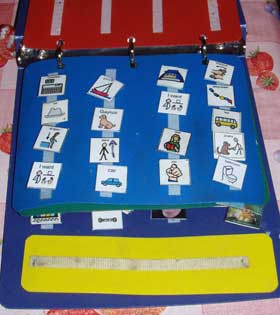Celebrating Blogging Against Disablism Day
Disablism Stops At Home
Siobhan (Sha-vonn) is 17 years old. She lives with her parents, Joseph (me) and Linda, in Santa Monica, California, USA. She attends Santa Monica High School, swims in the pool there nearly every day, and goes to occupational and physical therapy a few times a week. Siobhan has Cri-du-chat Syndrome, or Five P Minus (5p-). She is a mosaic; she has the transcription error in approximately 50 percent of her cells. Siobhan is ataxic (loss of full control of bodily movements) and hypotonic (abnormally low body tone) and she is developmentally disabled. She is also nearly completely non-verbal, but she has a communication system. None of her other classmates who need communication systems have one. I can’t help but feel that someone is selling those other students short. Disablism stops at home.
Wake Up!
“Time to get up!” says Mom. Dad goes to Siobhan’s bedroom, just off the kitchen and adjacent to an accessible bathroom. Dad releases Gaynor, Siobhan’s Canine Companions for Independence trained skilled companion dog, from her kennel in Siobhan’s room. Siobhan pulls the covers up. She shakes her head “no.” Dad uses a shaping technique to get her moving. “I have strawberries, and muffin, and cucumbers, and…” Siobhan flings off the covers and starts her day.
Picture Exchange Communication System
 Out on the kitchen table is her Pyramid Picture Exchange Communication System (PECS) book. This is a plastic binder with plastic pages inserted into it. The pages have Velcro strips, and on those strips are 1 inch size icons printed out from Boardmaker, glued to cardboard, overlaid with clear contact paper, and with a dot of Velcro on the back. She currently has 124 icons in her book. Also in the kitchen is a large binder with hundreds of 1 inch icons already made up for replacements or to swap in as needed for additional vocabulary. Maintaining this system is truly a labor of love.
Out on the kitchen table is her Pyramid Picture Exchange Communication System (PECS) book. This is a plastic binder with plastic pages inserted into it. The pages have Velcro strips, and on those strips are 1 inch size icons printed out from Boardmaker, glued to cardboard, overlaid with clear contact paper, and with a dot of Velcro on the back. She currently has 124 icons in her book. Also in the kitchen is a large binder with hundreds of 1 inch icons already made up for replacements or to swap in as needed for additional vocabulary. Maintaining this system is truly a labor of love.
Picture Schedule
Also in the kitchen is a picture schedule. This is a tall strip, also made of plastic, with one vertical strip of Velcro. On it are icons printed out in a 2.5 inch size for readability across the room. At the bottom of the schedule is a pocket for icons that are moved off the schedule as the activity is completed. Beside the schedule is a large binder with many pages of icons for the schedule. Mom comes on the scene and rearranges Siobhan’s schedule. Siobhan is all attention. Up on the schedule goes “car” and “school” and “swim.” Then comes a picture of who will be picking her up, followed by “physical therapy” if she has that and then probably “go home.” Siobhan can tell in an instant what she will be doing during the day by checking her schedule. A picture schedule is also used for her in her classroom. You can see her interacting with her schedule on YouTube.
Communication Book
Seated at the table Siobhan glances towards the schedule, sees car first up, and then begins to assemble her first sentence of the day. She opens her book, selects the “I want” icon, and places it on the sentence strip at the bottom of the book. She quickly scans the pages to find the next word. She selects “car” and places it on the strip, takes the strip off the book, and hands it to a communicative partner, me. I take the strip and as Siobhan points to the words I say “I want car.” I immediately return the sentence strip to her while I tell her that indeed, she’ll be going to school in the car very soon. The instant she gets the strip, she’s ready with her next sentence. “I want sandwich peanut butter.” That’s three icons. Siobhan rarely makes sentences with more than three icons. Syntax is flexible; though she always starts with a sentence starter such as “I want”, she omits articles and we tolerate “sandwich peanut butter” instead of insisting on “peanut butter sandwich.”
The Look
She usually follows up with “the look” which is one of intense concentration. She’s always had an effective way of communicating with her eyes, and this compelling gaze usually makes us hop to it. Grin!
Voice Output Device
Mom also takes Siobhan’s Dynavox MT4 (discontinued) off the charger, turns it on, and places it on the table in front of Siobhan. The communication book requires no batteries to run but is limited in the number of icons it can hold. It requires a communicative partner who is willing to take the sentence strip and read the icons, which have both pictures and words printed on them. The MT4 is a Voice Output Device or VOD. The MT4 is equipped with a touch screen, thousands of icons, powerful speakers, and a battery that lasts a good part of the day. Unlike the sentence strip that needs mediation, it gives Siobhan an immediately perceptible voice. We have arranged the pages in the VOD to approximate the communication book. We are using the same PECS methodology in both platforms. It is very important to have a methodology in place when moving to a VOD. See my CSUN 2009 presentation for details. We have changed the voice over the years to approximate Siobhan’s age. Currently Siobhan is using “Ursula” with a pitch of 37 and a volume of 73 in normal circumstances. The volume is raised and lowered to match her surroundings.
Communicating
As soon as the MT4 is in front of her, Siobhan turns it on. She hovers over the start sequence, excited to start talking. A flurry of sentences then come from the MT4 and from her communication book. Dad prepares her breakfast and Siobhan lets him know what’s missing. “I want grapes,” says the VOD, as she holds up a sentence strip that says “I want purse.” Siobhan has a mania for Mom’s purses. She asks Dad for purse all the time. Repeatedly. “I want cucumber.” “You already have cucumber in front of you” says Dad. “Cucumber.” “I want broccoli” with the VOD followed by “I want chicken” followed by a sentence strip “I want car” and for good measure another “I want purse.”
VOD and PECS
Siobhan uses both the VOD and the communication book almost interchangeably, though she comments almost exclusively with the VOD. Commenting on the VOD is enhanced by the use of Dynabooks – spring-loaded pictures that speak. We take a photograph and insert it into the MT4 – through what can only be described as a byzantine interface – and make the picture into a full page spread with speakable text that launches when Siobhan presses the appropriate icon.
Reinforcer-Based
PECS was designed to teach communication initiation by being reinforcer-based. There has to be a reward for communicating. You have to have what Siobhan wants in order to form the basis for communication. When Siobhan sees the picture of her godmother’s new baby and the VOD says “I gave Juliet a kiss, I love Juliet” that’s her reward for commenting. Siobhan lovingly gazes at the picture of herself kissing Juliet. And then she goes back and presses it again. Siobhan is rewarded, and we are rewarded by seeing her smile and she’s interacting with us a bit by commenting.
Picture Perfect
And so the morning hums along, Dad busily acting as short-order cook, Mom trying to wake up with very strong tea, Gaynor being fed and let outside to “Hurry!” and Siobhan all the while eating and commenting and putting in her orders. “I want crackers.” “Do it yourself” says Mom. Siobhan laughs because she knows that Dad will rescue her and give her some crackers. “I want crackers” says Siobhan. Dad delivers. He mostly always delivers. “I want leash” says Siobhan. She means Gaynor. She loves Gaynor. Siobhan pulls us all in for a group hug. Meanwhile, because Siobhan asked for it by name, the Lion King soundtrack is playing. It’s enough to drive one mad but the point is that she asked for it specifically with her own voice. By the way, we have words for the songs that are different than the original lyrics. Siobhan also asks for Cabaret. Cabaret! She’s very specific. Major win! “Two Ladies” is playing now. Gaynor is dancing with Linda. Siobhan is asking for the purse again. And this is a typical morning in the life of a successful communicator. I can’t imagine anything better.
Due to spam, comments are turned off, but you are welcome to discuss this with me:
@blacktelephone

 Today isÂ
Today isÂ